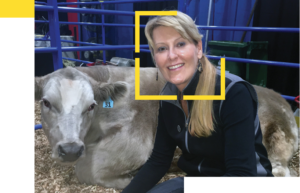Bonnie Mallard: From the barn to the bench
This is one in a series of profiles of the winners of the 2018 Governor General’s Innovation Awards. See all honourees.
From a young age, Dr. Bonnie Mallard desperately wanted to become a veterinarian, imagining herself making animals better. Today, she’s a veterinary researcher who makes better animals.
Mallard, an immunogeneticist at the Ontario Veterinary College, University of Guelph, has developed High Immune Response (HIR) technology that man- ages livestock health through genetic identification. The patented technology is licensed by a Canadian company called Semex Alliance, which markets the enhanced bovine semen under the trade name Immunity+.
Mallard calls her process of discovery “from the barn to the bench.” She began thinking about breeding animals for disease resistance in 1978 as an undergraduate in animal science at Guelph, where she learned that the immune system, which dictates response to infectious disease and cancers, is under genetic control.
“The concept was to be able to identify and breed animals, particularly food animals, for natural disease resistance, based on the quality of their immune response,” she explains. Over time she focused on animal breeding concepts to allow her to selectively breed livestock for improved health and food quality, and began to identify the superior genes associated with an enhanced ability to mount protective immunity.
Combining animal breeding and immunogenetics means that “high immune responders,” dairy livestock that have fewer diseases and require less antibiotics, are now available, Mallard says.
“Innovative ideas need leaders who can create new solutions, bring the right people and teams together and propel the ideas forward to important influencers. You are only as good as the people you surround yourself with. Find the right advisors and teammates. Build solid, credible relationships of integrity with colleagues, students and industry. This doesn’t happen overnight.”
“It’s about stopping animals from getting sick in the first place,” she points out. “If we can prevent disease, we’re saving money and we’re helping the animal, as well as bringing the consumer the quality of food they expect in Canada.”
Of course, there were challenges along the way. For example, much of the work on HIR was done first in pigs, which are an excellent genetic model given their large litters and short generation interval. HIR for swine was moving forward in commercial development but venture capital funds ran out before the project could be fully developed and reach the marketplace. The setback was a learning experience for Mallard.
“In many ways I am grateful for this failure, since I learned how to move forward more effectively when the next opportunities came around,” she says. “The bottom line is to learn from your mistakes … You may fail and fall down during the journey, but get up to try again.”
She says it’s important to “nurture the entrepreneurial spirit by creating an environment where inspiration, ideation and investigation can flourish. Innovation, industry investment and implementation will flow out from there.”
Appropriate mentorship is critical, she believes. “Wisdom and discernment are required at each stage to know when and how to move forward.” Additionally, undergrads should have opportunities to do special projects. Effective, relational and well- funded university business development offices are also needed “to help professors confidently get their ideas through the gap.”
She says it’s particularly important to remove barriers to innovation in university settings. “Professors who are trained to be creative leaders get bogged down with administrative duties and red tape,” Mallard explains. “I think they need more support in this area to free their time to do what they do best — create and innovate.”
She credits those around her for the success of HIR. “I have been blessed with fabulous mentors, students, postdocs and technical staff that have helped me at each stage of HIR. The people at Semex have been very supportive and meshed well with my group. It was an ideal fit for this project,” she says.
Semex, Canada’s largest livestock breeding company, has generated more than $60-million in the first three years of sales of Immunity+ semen, which is available in 120 countries.
Meanwhile, Mallard is looking for other applications and improvements to HIR. “This keeps the innovative cycle energized and productive,” she says. Her team is working with various organizations to adapt the HIR technology for beef cattle, pigs and horses. She’d like to see it used in other animals such as poultry, sheep, goats and even dogs.
“All animals deserve to be healthy and happy. It’s part of good stewardship,” Mallard says. “My former and current students will carry many of these initiatives forward, hopefully long after I retire. That’s the kind of legacy that I hope to enjoy.”






